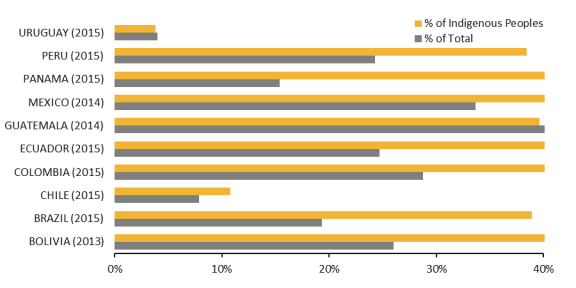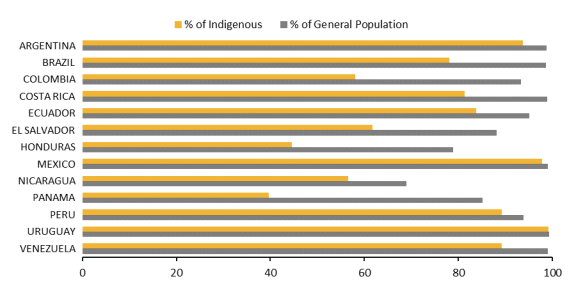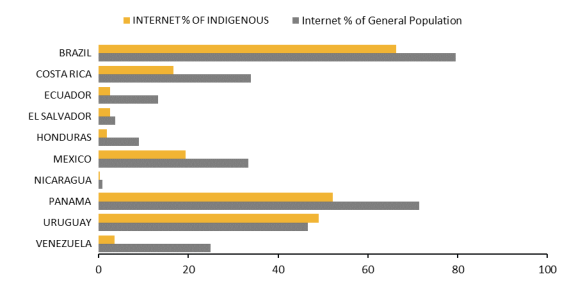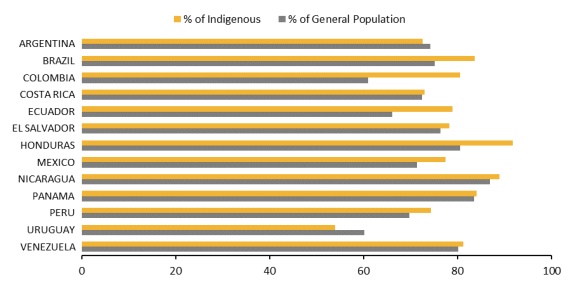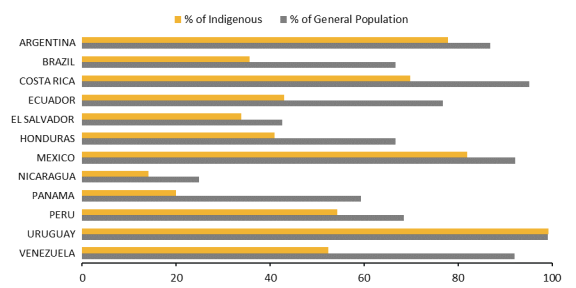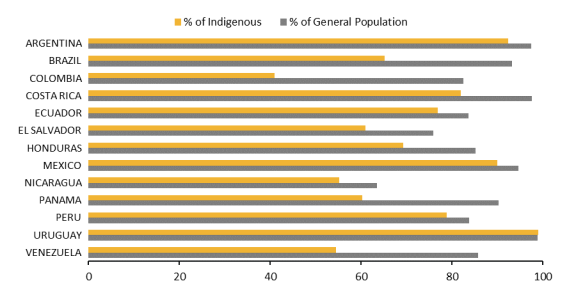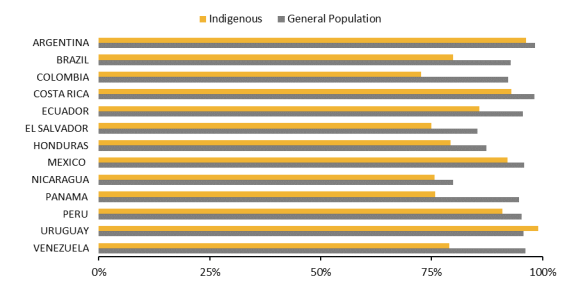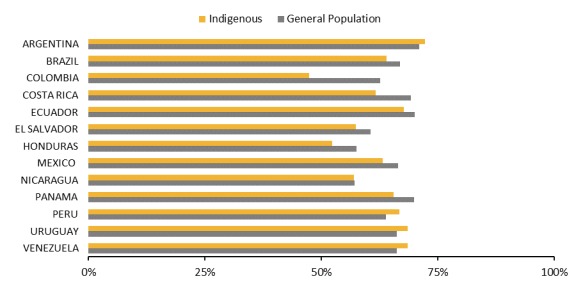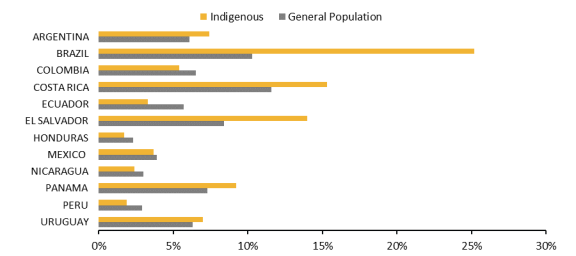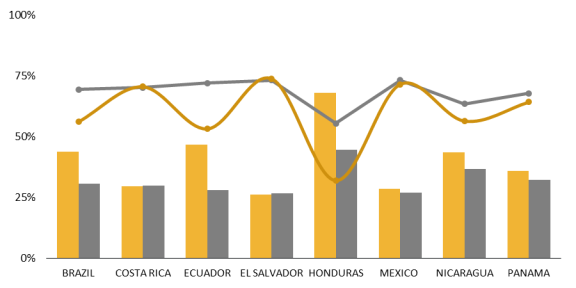Introduction
Congress has long been interested in the status of indigenous peoples abroad. In 1992, the 102nd Congress enacted H.R. 5368 (P.L. 102-391) requiring the State Department's annual human rights report to "describe the extent to which indigenous people are able to participate in decisions affecting their lands, cultures, traditions and the allocation of natural resources, and assess the extent of protection of their civil and political rights." Issues relating to indigenous peoples periodically have been considered in hearings focused on such issues as environmental protection, energy opportunities, and security cooperation.1
This report provides statistical information on indigenous peoples in Latin America, including populations and languages, socioeconomic data, land and natural resources, human rights, and international legal conventions. Resource lists for each section (languages; socioeconomics; land and resources; international organizations; and human rights) are available in the tables of Appendix A. Table B-1 lists national agencies that oversee indigenous affairs in each country.
Terms
Definitions of indigenous peoples vary. The United Nations (U.N.) has not adopted an official definition, but instead relies on self-identification to categorize indigenous populations around the world; many countries do the same. However, the U.N. web page dedicated to indigenous peoples does state "indigenous peoples are inheritors and practitioners of unique cultures and ways of relating to people and the environment. They have retained social, cultural, economic and political characteristics that are distinct from those of the dominant societies in which they live."2 The annex of the U.N. Declaration on the Rights of Indigenous Peoples states "indigenous peoples have suffered from historic injustices as a result of, inter alia, their colonization and dispossession of their lands, territories and resources."
The Organization of American States' (OAS) American Declaration on the Rights of Indigenous Peoples repeats the U.N. Declaration language and adds "indigenous peoples are original, diverse societies with their own identities that constitute an integral part of the Americas." According to OAS estimates, there are more than 50 million people of indigenous descent in the Western hemisphere. This report examines those living in Latin American and the Caribbean.
According to the Manual for National Human Rights Institutions that accompanied the U.N. Declaration on the Rights of Indigenous Peoples, "indigenous peoples have argued against the adoption of a formal definition at the international level, stressing the need for flexibility and for respecting the desire and the right of each indigenous people to define themselves.… As a consequence, no formal definition has been adopted in international law. A strict definition is seen as unnecessary and undesirable."3
In counting distinct groups, this report uses the term "indigenous groups" rather than "tribe," "nation," "ethnic minority," or "sociolinguistic group."
A 2019 United Nations report included sections titled "the need for disaggregated data" and "the persistent invisibility of indigenous peoples" to address data limitations regarding indigenous people around the globe. However, the report notes progress in Latin America: "only two censuses included self-identification criteria in the 1990 round, but by the 2010 round such criteria were present in 21 of them."4 Despite some advances, the sources cited in this report contain data limitations, which are discussed in Appendix A. The countries listed in each table or graph may differ from others in this report based on the information available in the sources.
Population Data
Latin America is home to 29-45 million indigenous people according to several studies that provided estimates for around 2010.5 The World Bank stated in a report that "official data on indigenous people are not conclusive, as many technical and sociological difficulties persist in census data collection. Other sources based on estimates and unofficial data refer to 50 million indigenous inhabitants in Latin America (about 10 percent of the total population). For this report, however, we will refer to the official—albeit imperfect—numbers provided by the national censuses [41.81 million]."6 Figure 1 illustrates the total number of indigenous people and their share of the total population according to three sources: a 2009 UNICEF report, a 2015 report from the Economic Commission for Latin America and the Caribbean (ECLAC), and a 2015 World Bank Report. Census projections forecast indigenous population increases in many countries in part due to populations that are younger on average than non-indigenous populations and in part due to an increase in self-identification.7
Table 1 shows a breakdown by country of indigenous populations and their share of the overall population. CRS created the following tables from several sources; publication dates and methodologies differed. The countries listed in each table may differ from others in this report based on the information available in the sources.
|
Country |
UNICEF 2009 Indigenous Population (% of general pop.)a |
ECLAC 2014 Indigenous Population (% of general pop.)b |
WB 2015 Indigenous Population (% of general pop.)c |
|
Argentina |
600,329 (1.6%) |
955,032 (2.4%) |
955,032 (2.4%) |
|
Belize |
38,562 (16.6%) |
N/A |
N/A |
|
Bolivia |
5,358,107 (66.2%) |
6,216,026 (62.2%) |
4,115,226 (41%) |
|
Brazil |
734,127 (0.4%) |
896,917 (0.5%) |
817,963 (0.5%) |
|
Chile |
692,192 (4.6%) |
1,805,243 (11%) |
788,935 (4.6%) |
|
Colombia |
1,392,623 (3.3%) |
1,559,852 (3.4%) |
1,532,678 (3.3%) |
|
Costa Rica |
65,548 (1.7%) |
104,143 (2.4%) |
104,143 (2.4%) |
|
Ecuador |
830,418 (6.8%) |
1,018,176 (7%) |
1,018,176 (7%) |
|
El Salvador |
13,310 (0.2%) |
14,408 (0.2%) |
14,865 (0.2%) |
|
Guatemala |
4,487,026 (39.9%) |
5,881,009 (41%) |
5,880,046 (41%) |
|
Guyana |
68,819 (9.1%) |
N/A |
N/A |
|
Honduras |
440,313 (7.2%) |
536,541 (7%) |
548,727 (7.2%) |
|
Mexico |
9,504,184 (9.4%) |
16,933,283 (15.1%) |
16,836,877 (15%) |
|
Nicaragua |
292,244 (5.7%) |
518,104 (8.9%) |
349,333 (6%) |
|
Panama |
285,231 (10%) |
417,559 (12.3%) |
417,559 (12.2%) |
|
Paraguay |
108,308 (2%) |
112,848 (1.8%) |
112,848 (1.7%) |
|
Peru |
3,919,314 (13.9%) |
7,021,271 (24%) |
7,596,039 (26%) |
|
Suriname |
6,601 (1.5%) |
N/A |
N/A |
|
Uruguay |
115,118 (3.5%) |
76,452 (2.4%) |
N/A |
|
Venezuela |
534,816 (2.3%) |
724,592 (2.7%) |
724,592 (2.8%) |
|
TOTAL |
29,373,208 (6.1%) |
44,791,456 (8.3%) |
41,813,039 (7.8%) |
Source: Compiled by CRS using the following sources: UNICEF and FUNPROEIB Andes' (UNICEF) 2009 Atlas Sociolingüístico de Pueblos Indígenas en América Latina; Economic Commission for Latin America and the Caribbean's (ECLAC) 2014 Guaranteeing indigenous people's rights in Latin America: Progress in the past decade and remaining challenges; and the World Bank Group's (WB) 2015 Indigenous Latin America in the twenty-first century: the first decade.
Notes:
a. UNICEF and FUNPROEIB Andes' 2009 Atlas covered 25 countries in Latin America and the Caribbean and the population figures vary by country from 1999 to 2008.
b. ECLAC's 2014 report covered 17 countries in Latin America with population figures "according to censuses and estimates, around 2010."
c. The World Bank's 2015 report covered 16 countries in Latin America and the population figures vary by country from 2001 to 2012 with some projections for 2010.
Figure 2 illustrates the range of estimates regarding the indigenous population as a percentage of the general population in each country. Bolivia's steep decrease in the indigenous population reflects "reasons that probably have more to do with discrepancies in how the data were collected between the last two censuses than with a real trend to negative growth," according to the World Bank.8 More generally, differences in data collection between censuses and across countries make it difficult to estimate population increases.
|
Figure 2. Indigenous Population in Latin America as Percentage of General Population by Country |
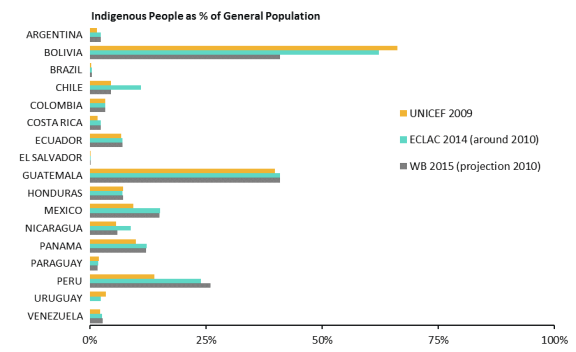 |
|
Source: Graphic created by CRS using UNICEF and FUNPROEIB Andes' (UNICEF) 2009 Atlas Sociolingüístico de Pueblos Indígenas en América Latina; the International Bank for Reconstruction and Development and World Bank's (WB) 2015 Indigenous Latin America in the twenty-first century: the first decade; and the Economic Commission for Latin America and the Caribbean's (ECLAC) 2014 Guaranteeing indigenous people's rights in Latin America: Progress in the past decade and remaining challenges. Notes: The sources note that figures are based on national censuses. For more details see Appendix A. |
Indigenous Groups and Languages
To raise awareness and mobilize action, the U.N. declared 2019 the International Year of Indigenous Languages,9 yet figures on indigenous groups and languages vary among sources.
|
Data on indigenous ethnic groups "As for the number and distribution of ethnic groups, the issue is even more problematic and the regional censuses might not be the best source, because ethnic frontiers rarely match national borders and no country keeps track of cross-border populations. Also, different ethnic groups sometimes receive… names given to several unconnected peoples…. On the other hand, a single group or linguistic family might receive different names in different countries—such as the several groups of Maya peoples inhabiting a large area of southern Mexico and Central America." -- World Bank's Indigenous Latin America in the twenty-first century: the first decade10 |
Figure 3 shows the total number of indigenous groups in Latin America as identified by three sources. A 2009 UNICEF report identified a total of 655 indigenous groups in Latin America.11 The 2014 ECLAC report cites 826 indigenous groups in Latin America although it does not provide a country breakdown.12 Of these 826, about 200 indigenous groups live in voluntary isolation, which is defined by an Inter-American Commission on Human Rights report as groups that "do not maintain sustained contacts with the majority non-indigenous population."13 The World Bank's 2015 report identifies 772 indigenous groups in Latin America.14
According to several sources, indigenous languages number fewer than the number of indigenous groups across the region (see Figure 4). The 2015 World Bank report found 558 indigenous languages across 20 countries of Latin America,15 while a 2009 UNICEF report found 551 languages across the same 20 countries.16 Of these 551, the latter report found that 111 languages are vulnerable to extinction although five (Quechua, Nahuatl, Aymara, Yucatan Maya, and Ki'che') had over a million speakers each. In 2019, the Summer Institute of Linguistics (SIL International) reported 880 indigenous languages are spoken across the same 20 Latin American countries.17
Table 2 shows a breakdown of Latin America's indigenous groups and languages by country according to two sources. CRS created the table from several sources; publication dates and methodologies differed. The countries listed in each table may differ from others in this report based on the information available in the sources.
|
Country |
UNICEF 2009 Indigenous Groups (languages)a |
WB 2015 Indigenous Groups (languages)b |
|
Argentina |
30 (15) |
30 (15) |
|
Belize |
4 (4) |
4 (4) |
|
Bolivia |
36 (33) |
114 (33) |
|
Brazil |
241 (186) |
241 (186) |
|
Chile |
9 (6) |
9 (6) |
|
Colombia |
83 (65) |
83 (65) |
|
Costa Rica |
8 (7) |
8 (7) |
|
Ecuador |
12 (12) |
32 (13) |
|
El Salvador |
3 (1) |
3 (1) |
|
Guatemala |
24 (24) |
24 (24) |
|
Guyana |
9 (9) |
9 (9) |
|
Honduras |
7 (6) |
7 (6) |
|
Mexico |
67 (64) |
67 (67) |
|
Nicaragua |
9 (6) |
9 (6) |
|
Panama |
8 (8) |
7 (7) |
|
Paraguay |
20 (20) |
20 (20) |
|
Peru |
43 (43) |
52 (47) |
|
Suriname |
5 (5) |
5 (5) |
|
Uruguay |
0 (0) |
0 (0) |
|
Venezuela |
37 (37) |
50 (37) |
|
TOTAL |
655 (551) |
774 (558) |
Source: Graphic created by CRS using UNICEF and FUNPROEIB Andes' (UNICEF) 2009 Atlas Sociolingüístico de Pueblos Indígenas en América Latina; and the International Bank for Reconstruction and Development and World Bank's (WB) 2015 Indigenous Latin America in the twenty-first century: the first decade.
Notes: This report uses "peoples" rather than "tribe," "nation," "ethnic minority," or "sociolinguistic group."
a. While UNICEF and FUNPROEIB Andes' 2009 Atlas covered 25 countries in Latin America and the Caribbean, Antigua and Barbuda, Dominica, French Guiana, Saint Lucia and Trinidad and Tobago are not otherwise included.
b. While the World Bank's 2015 report covered 16 countries in Latin America, French Guiana is not included in this report.
According to the U.S. Census Bureau, approximately 15,000-19,000 indigenous language speakers from Latin America reside in the United States.18
Additional resources about indigenous groups and languages can be found in Table A-1.
Socioeconomic Data
In a 2015 publication, the World Bank found that 43% of indigenous people in Latin America are poor (living on less than $5.50 a day in 2011 purchasing power parity prices or PPP), and 24% are extremely poor (living on less than $1.90 a day in 2011 PPP prices), more than twice the rates for non-indigenous people. The report also documented education gaps were across the region.19 Drawing from another World Bank resource, Figure 5 compares rates of indigenous peoples living on less than $5.50 a day compared to the general population in select countries of Central and South America.
The World Bank provides statistics on access to various services and opportunities for indigenous peoples in select countries of Central and South America, last updated in October 2018. The following graphs compare indigenous rates of access to these amenities compared with the general population rates by country (Figure 6, electricity; Figure 7, internet; Figure 8, home ownership; Figure 9, sewage; and Figure 10, water).
The World Bank also provides labor and education statistics for indigenous peoples in select countries of Central and South America, last updated in October 2018. The following graphs compare indigenous rates compared with general population rates by country (Figure 11, literacy; Figure 12, school attendance; Figure 13, unemployment; and Figure 14, low-skill and high-skill employment).
In the appendix, Table A-2 lists resources relating to the socioeconomic standing of indigenous peoples in Latin America.
Land and Natural Resources
A 2017 World Resources Institute (WRI) report states "the precise amount of communal land is not known, but many experts argue that at least half of the world's land is held by Indigenous Peoples and other communities. Some estimates are as high as 65 percent or more of the global land area." The WRI goes on to specify that "globally, Indigenous Peoples and local communities have formal legal ownership of 10 percent of the land, and have some degree of government-recognized management rights over an additional 8 percent."20
The United Nations' Economic Commission for Latin America and the Caribbean's (ECLAC) 2014 report Guaranteeing indigenous people's rights in Latin America: Progress in the past decade and remaining challenges states that "over the past decade, booming international demand for primary goods (minerals, hydrocarbons, soybeans and other agricultural commodities) has boosted economic growth in the countries of Latin America but has had its cost in the form of a growing number of environmental, social and ethnic conflicts involving extractive industries located in or near indigenous territories."21
According a 2012 Forest Peoples Programme global report, "[A]n estimated 350 million people live inside or close to dense forests, largely dependent on these areas for subsistence and income, while an estimated range of 60 million to 200 million indigenous people are almost wholly dependent on forests."22 For the region of Mexico, Central and South America, the report estimates 42-48 million indigenous peoples and 21-26 million forest peoples.23 Some but not all indigenous peoples are also forest peoples. Some countries did not have population figures for forest people.
A 2018 Science article classifies drivers of global tree cover loss using satellite imagery. In Latin America, deforestation accounts for over half of the tree cover loss, shifting agriculture about a third, and, to a smaller degree, forestry, wildfire, and urbanization.24
In the 2015 report Indigenous Peoples, Communities of African Descent, Extractive Industries, the IACHR wrote that "through the implementation of its monitoring mechanisms, the Commission has consistently received information evidencing the human, social, health, cultural and environmental impacts of [extraction, exploitation, and development activities concerning natural resources] on indigenous peoples and Afrodescendent communities. Many extractive and development activities in the hemisphere are implemented in lands and territories historically occupied by indigenous and Afro-descendent communities, which often coincide with areas hosting a great wealth of natural resources."25
Table A-3 lists resources about indigenous peoples' lands and natural resources in Latin America. While the titles may not exclusively focus on indigenous peoples, the industries' impact on indigenous people is a part of the analysis of each resource.
Human Rights and Multilateral Instruments
Various international human rights mechanisms protect the rights of indigenous peoples of Latin America and the Caribbean. Table 3 identifies those countries that have ratified or voted in favor of the following three multilateral instruments on indigenous peoples' rights:
- International Labor Organization's Indigenous and Tribal Peoples Convention, 1989 (No. 169).26 The convention includes sections on land; recruitment and conditions of employment; vocational training, handicrafts and rural industries; and social security and health; education and means of communication.
- United Nations Declaration on the Rights of Indigenous Peoples (UNDRIP).27 The 2007 declaration covers such topics as self-determination or autonomy; land and environment; employment; religion; language and media; education; discrimination and violence; and health.
- American Declaration on the Rights of Indigenous Peoples (ADRIP).28 The 2016 declaration approved by the Organization of American States includes sections on human and collective rights; cultural identity; organizational and political rights; and social, economic and property rights.
|
Country |
Ratified ILO No. 169a |
Voted in favor of adopting UNDRIP |
Voted in favor of adopting ADRIP |
|
Argentina |
X |
X |
X |
|
Belize |
X |
X |
|
|
Bolivia |
X |
X |
X |
|
Brazil |
X |
X |
X |
|
Chile |
X |
X |
X |
|
Colombia |
X |
Xb |
Xc |
|
Costa Rica |
X |
X |
X |
|
Ecuador |
X |
X |
X |
|
El Salvador |
-- |
X |
X |
|
Guatemala |
X |
X |
X |
|
Guyana |
-- |
X |
X |
|
Honduras |
X |
X |
X |
|
Jamaica |
-- |
X |
X |
|
Mexico |
X |
X |
X |
|
Nicaragua |
X |
X |
X |
|
Panama |
-- |
X |
X |
|
Paraguay |
X |
X |
X |
|
Peru |
X |
X |
X |
|
Suriname |
-- |
X |
X |
|
Uruguay |
-- |
X |
X |
|
Venezuela |
X |
X |
X |
Source: Compiled by CRS using the following sources: ILO's web page "Ratifications of C169 - Indigenous and Tribal Peoples Convention, 1989 (No. 169)," the U.N. web page "United Nations Declaration on the Rights of Indigenous People," and the OAS' official publication of ADRIP.
Notes:
a. International Labor Organization, "Ratifications of C169 - Indigenous and Tribal Peoples Convention, 1989 (No. 169)," at https://www.ilo.org/dyn/normlex/en/f?p=1000:11300:0::NO:11300:P11300_INSTRUMENT_ID:312314.
b. From the region, only Colombia abstained from the vote. See U.N, Department of Economic and Social Affairs, "United Nations Declaration on the Rights of Indigenous People," September 13, 2007, at https://www.un.org/development/desa/indigenouspeoples/declaration-on-the-rights-of-indigenous-peoples.html.
c. In the footnotes, Colombia "breaks with consensus" on paragraphs within Articles XXIII, XXIX, and XXX. See Organization of American States, "American Declaration on the Rights of Indigenous Peoples," June 15, 2016, at https://www.oas.org/en/sare/documents/DecAmIND.pdf.
d. Cuba is not a voting member. See Organization of American States, "Member States," accessed on April 22, 2019, at http://www.oas.org/en/member_states/default.asp.
The United Nations has a Permanent Forum on Indigenous Issues and in 2001 created the Special Rapporteurship on the Rights of Indigenous Peoples, which promote the rights of indigenous peoples across the globe.29 In 1990, the Organization of American States created the Rapporteurship on the Rights of Indigenous Peoples to promote the rights of indigenous peoples throughout the Western Hemisphere.30 Table A-4 provides additional resources about the work of international organizations with indigenous peoples.
In a 2000 report, the Inter-American Commission on Human Rights (IACHR) wrote "concern for the human rights of indigenous peoples and their members has been a constant feature in the work of the Commission."31 The IACHR has tracked its work involving indigenous peoples. It hosts multiple sessions per year to hold hearings regarding human rights issues affecting a particular country or subregion of the Western Hemisphere. One of the categories for hearings is the rights of indigenous peoples. Table 4 shows the number of IACHR hearings by country involving indigenous peoples' rights. It also shows the number of Inter-American Court of Human Rights cases brought by indigenous peoples against countries.
Table 4. Human Rights Hearings and Cases about the Rights of Indigenous Peoples in the Inter-American System 1996-2019
|
Country |
Hearings on the Rights of Indigenous Peoples |
Cases brought by Indigenous Peoples |
|
Colombia |
25 |
1 |
|
Peru |
20 |
0 |
|
Guatemala |
17 |
5 |
|
Ecuador |
13 |
2 |
|
Mexico |
12 |
2 |
|
Brazil |
11 |
1 |
|
Chile |
9 |
0 |
|
Panama |
8 |
1 |
|
Argentina |
8 |
1 |
|
Bolivia |
8 |
0 |
|
Nicaragua |
8 |
1 |
|
Honduras |
7 |
1 |
|
Venezuela |
4 |
0 |
|
Costa Rica |
4 |
0 |
|
Paraguay |
3 |
2 |
|
Belize |
2 |
0 |
|
Suriname |
1 |
2 |
|
Guyana |
1 |
0 |
|
Regionala |
27 |
N/A |
Source: CRS table created using data from the IACHR's Rapporteurship on the Rights of Indigenous Peoples and reflects sessions 91-172 (February 1996-September 2019).
Notes: Hearings include topical hearings as well as cases, petitions, and precautionary measures. Hearings information is not available for all sessions, particularly before 1996.
a. The IACHR uses this category for hearings that span multiple countries. Where countries were named along with the tag "regional," the hearing was counted for all entities tagged.
In the appendix, Table A-5 lists publications that document various human rights issues confronting indigenous peoples. CRS also publishes a number of reports with country-specific information on indigenous peoples' human rights issues.32
Appendix A. Data Sources and Resources Lists
The United Nations Children's Fund (UNICEF) and Fundación para la Educación en Contextos de Multilingüismo y Pluriculturalidad (the Foundation for Education in Multilingual and Multicultural Contexts or FUNPROEIB) gathered data in 21 Latin American and Caribbean countries in 2009 for its report in two volumes titled Atlas Sociolingüístico de Pueblos Indígenas en América Latina. The report notes the limitations of using national censuses.33
In 2014, the United Nations' Economic Commission for Latin America and the Caribbean (ECLAC) gathered population data from 17 Latin American countries using national censuses for Guaranteeing Indigenous People's Rights in Latin America: Progress in the past Decade and Remaining Challenges. The report notes that most countries ask people to self-identify as indigenous with the exception of Peru, which asks people if they speak an indigenous language.34
In 2015, the World Bank gathered data in 16 countries using national censuses and household survey data in order to publish Indigenous Latin America in the Twenty-First Century: the First Decade.35 The report notes that the definition of who is indigenous has become increasingly controversial and "underscores the complexity of identifying indigenous people across the region and argues that the conditions of indigeneity vary over time and are, in some cases, context- and country-specific."36
The current edition of Ethnologue documents language counts for each country and divides them into indigenous and non-indigenous categories. Indigenous languages figures were used in Table 2 as non-indigenous is defined as "a language that did not originate in the country, but which is now established there either as a result of its longstanding presence or because of institutionally supported use and recognition."37 Only living languages were included in the count, not languages classified as extinct. Ethnologue's "about" section provides details on the methodology, language names, and status of usage.
The World Bank's Latin America and Caribbean Equity Lab provides data on poverty, access to services, education and labor (last updated in October 2018). The World Bank notes that ethnic identity is based on self-reported data. Statistics may vary from official statistics reported by governments as the World Bank uses SEDLAC, "a regional data harmonization effort that increases cross-country comparability."
The web page of the Inter-American Commission's Human Rights Rapporteurship on the Rights of Indigenous Peoples provides detailed information on hearings and court cases related to indigenous peoples' rights.
The data on drivers of forest loss in Latin America are from: Philip G. Curtis, Christy M. Slay, Nancy L. Harris, Alexandra Tyukavina, Matthew C. Hansen, "Classifying drivers of global forest loss," Science, Vol. 361, Issue 6407, pp. 1108-1111, September 14, 2018, at https://science.sciencemag.org/content/361/6407/1108. There are multiple methodologies for each driver of forest loss using map-based estimates and sample-based estimates.
For each table below, sources are listed in reverse chronological order with the year in parentheses following the title. Multiple sources from the same year are listed alphabetically as are sources without a publication date, such as websites. Some sources are global, with a section dedicated to Latin America.
|
Title |
Author |
Resource Type |
URL |
|
Celebrating Indigenous Languages (2019) |
Google Earth |
Interactive website |
https://earth.google.com/web/data=CiQSIhIgYTY1Y2U1NTk3MzE4MTFlOTkzN2RjN2JkNTNhNDc1ZGI |
|
International Year of Indigenous Languages (2019) |
United Nations |
Website |
|
|
Languages of the World, Twenty-second edition (2019) |
David M. Eberhard, Gary F. Simons, and Charles D. Fenning (editors), Ethnologue |
Language encyclopedia |
|
|
Atlas Sociolingüístico de Pueblos Indígenas en América Latina, Volúmenes I and II (2009) |
UNICEF and FUNPROEIB Andes |
Report in Spanish |
https://www.unicef.org/honduras/tomo_1_atlas.pdf; https://www.unicef.org/honduras/tomo_2_atlas.pdf |
Source: Compiled by CRS.
|
Title |
Author |
Resource Type |
URL |
|
Linking Indigenous Communities with Regional Development (2019) |
Organization for Economic Cooperation and Development |
Report on OECD member countries including Chile and Mexico with some information on non-member countries |
|
|
State of the world`s indigenous peoples: Education, 3rd volume (2017) |
United Nations |
Report |
|
|
Indigenous Latin America in the twenty-first century: the first decade (2015) |
International Bank for Reconstruction and Development and the World Bank |
Report |
|
|
The state of the world´s indigenous people: Indigenous people´s access to health services, 2nd volume (2015) |
United Nations |
Report |
|
|
LAC Equity Lab: A Platform for Poverty and Inequality Analysis |
World Bank |
Regional economic data and maps |
Source: Compiled by CRS.
|
Title |
Author |
Resource Type |
URL |
|
Blood Gold in the Brazilian Rain Forest (2019) |
Jon Lee Anderson, The New Yorker |
Long article |
|
|
Rainforest Mafias: How Violence and Impunity Fuel Deforestation in Brazil's Amazon (2019) |
Human Rights Watch |
Report |
|
|
Situation of Human Rights of the Indigenous and Tribal Peoples of the Pan-Amazon Region (2019) |
Inter-American Commission on Human Rights |
Report |
http://www.oas.org/en/iachr/reports/pdfs/Panamazonia2019-en.pdf |
|
Looted Amazon (2018) |
Infoamazonia and Amazon Georeferenced Socio-Environmental Information Network |
Report |
|
|
Organized Crime and Illegally Mined Gold in Latin America (2016) |
Global Initiative against Transnational Organized Crime |
Report |
https://globalinitiative.net/organized-crime-and-illegally-mined-gold-in-latin-america/ |
|
Amazonía Socioambiental |
Amazon Geo-Referenced Socio-Environmental Information Network, a consortium of civil society organizations from several countries |
Maps and publications (English, Spanish, Portuguese) |
|
|
Environmental Justice Atlas |
Autonomous University of Barcelona's Institute of Environmental Science and Technology |
Map with information about level of conflict, communities, commodities, companies, and governmental agencies involved, and reference links |
|
|
Indigenous peoples and food security in Latin America and the Caribbean |
FAO Regional Office for Latin America and the Caribbean |
Website |
http://www.fao.org/americas/prioridades/pueblos-indigenas/en/ |
|
Authorized to Steal: Organized Crime Networks Launder Illegal Timber from the Peruvian Amazon (2019) |
Center for International Environmental Law |
Report |
https://www.ciel.org/wp-content/uploads/2019/07/Authorized-to-Steal-July-2019.pdf |
|
Landmark Map |
World Resources Institute, International Land Coalition and others |
Maps, data, country profiles |
Source: Compiled by CRS.
|
Title |
Author |
Resource Type |
URL |
|
The state of the world´s indigenous people: Implementing the United Nations Declaration on the Rights of Indigenous Peoples, 4th volume (2019) |
United Nations |
Report |
|
|
Indigenous Peoples and Local Communities Portal |
World Intellectual Property Organization |
Website provides access to publications and events |
|
|
Indigenous Peoples—OAS |
Organization of American States |
Website provides access to the Rapporteurship on the Rights of Indigenous Peoples of the Inter-American Commission on Human Rights, Summits of the Americas, special projects and more |
|
|
Indigenous and tribal peoples |
International Labor Organization |
Website provides access to projects, publications and supervision of conventions |
https://www.ilo.org/global/topics/indigenous-tribal/lang--en/index.htm |
|
United Nations for Indigenous Peoples |
United Nations' Department of Economic and Social Affairs |
Website provides access to the Permanent Forum on Indigenous Issues, the World Conference on Indigenous Peoples, expert group meetings, the Special Rapporteur on the rights of indigenous peoples and more |
Source: Compiled by CRS.
|
Title |
Author |
Resource Type |
URL |
|
Front Line Defenders Global Analysis 2019 (2020) |
Front Line Defenders |
Report about physical, digital, legal and social attacks against human rights defenders |
https://www.frontlinedefenders.org/sites/default/files/global_analysis_2019_web.pdf |
|
Indigenous Navigator (2018) |
Community-generated data, website supported by the European Union |
Website and database |
|
|
Indigenous Women and Their Human Rights in the Americas (2017) |
Inter-American Commission on Human Rights |
Report with hearings, cases, thematic and country reports that document violations of the human rights of indigenous women |
http://www.oas.org/en/iachr/reports/pdfs/IndigenousWomen.pdf |
|
Guaranteeing indigenous people's rights in Latin America: Progress in the past decade and remaining challenges (2014) |
Economic Commission for Latin America and the Caribbean |
Report |
https://repositorio.cepal.org/bitstream/handle/11362/37051/4/S1420782_en.pdf |
|
Captive Communities: Situation of the Guaraní Indigenous People and Contemporary Forms of Slavery in the Bolivian Chaco (2009) |
Inter-American Commission on Human Rights |
Report with background information and state legislation and initiatives |
https://www.oas.org/en/iachr/indigenous/docs/pdf/CAPTIVECOMMUNITIES.pdf |
|
Country Reports on Human Rights Practices |
U.S. State Department |
Annual report with chapters about each country with section "Discrimination, Societal Abuses, and Trafficking in Persons" that includes indigenous peoples |
|
|
Indigenous World |
International Work Group for Indigenous Affairs |
Annual report about developments affecting indigenous peoples with chapters about each country |
Source: Compiled by CRS.
Appendix B. National Agencies of Indigenous Affairs
|
Country |
Agency (parent agency, office) |
Website |
|
Argentina |
Secretaría de Derechos Humanos, Instituto Nacional de Asuntos Indígenas |
|
|
Bolivia |
Ministerio de Culturas y Turismo, Viceministro de Interculturalidad & Viceministro de Descolonización |
http://www.minculturas.gob.bo/es/articulo/336-viceministro-de-interculturalidad http://www.minculturas.gob.bo/es/articulo/17-viceministro-de-descolonizacin |
|
Brazil |
Ministério da Mulher, da Família e dos Direitos Humanos, Fundação Nacional do Índio; Ministério da Agricultura, Pecuária e Abastecimento |
|
|
Chile |
Ministerio de Desarrollo Social, Corporación Nacional de Desarrollo Indígena |
|
|
Colombia |
Ministerio del Interior, Viceministerio para la Participación e Igualdad de Derechos, Dirección de Asuntos Indígenas, ROM y Minorías |
https://www.mininterior.gov.co/mision/direccion-de-asuntos-indigenas-rom-y-minorias |
|
Costa Rica |
Comisión Nacional de Asuntos Indígenas |
|
|
Ecuador |
Consejo Nacional para la Igualdad de Pueblos y Nacionalidades |
|
|
El Salvador |
Ministerio de Cultura, Departamento de Pueblos Indígenas |
http://www.cultura.gob.sv/departamento-de-pueblos-indigenas/ |
|
Guatemala |
Ministerio Público, Secretaría de Pueblos Indígenas |
|
|
Guyana |
Ministry of Indigenous Peoples' Affairs |
|
|
Honduras |
Secretaría de Desarrollo e Inclusión Social, Dirección de Pueblos Indígenas y Afrohondureños |
|
|
Mexico |
Instituto Nacional de los Pueblos Indígenas; Secretaría de Cultura, Instituto Nacional de Lenguas Indígenas; |
|
|
Nicaragua |
Asamblea Nacional, Comisión de Asuntos de los Pueblos Originarios, Afrodescendientes y Regímenes Autonómicos; Comisión Nacional de Demarcación y Titulación |
http://legislacion.asamblea.gob.ni/Tablas%20Generales.nsf/InfoComision.xsp |
|
Panama |
Ministerio de Gobierno y Justicia, Viceministerio de Asuntos Indígenas; Ministerio de Salud, Dirección de Asuntos Sanitarios Indígenas |
http://www.mingob.gob.pa/viceministerio-asuntos-indigenas/ http://www.minsa.gob.pa/direccion/direccion-de-asuntos-sanitarios-indigenas |
|
Paraguay |
Presidencia de la República, Instituto Paraguayo del Indígena |
|
|
Peru |
Ministerio de Cultura, Viceministerio de Interculturalidad, Dirección de Políticas indígenas |
http://cultura.gob.pe/es/interculturalidad/politicasindigenas |
|
Uruguay |
Ministerio del Interior, Área Étnico Racial |
https://www.minterior.gub.uy/index.php?option=com_content&view=article&id=3447 |
|
Venezuela |
Ministerio del Poder Popular para los Pueblos Indígenas |
Source: Compiled by CRS.



